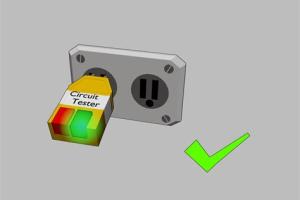How to Properly Ground an Electrical Outlet: A Complete Guide

-
Quick Links:
- Introduction
- Why Ground an Outlet?
- Understanding Grounding in Electrical Systems
- Tools and Materials Needed
- Step-by-Step Guide to Grounding an Outlet
- Common Mistakes to Avoid
- Case Studies and Real-World Examples
- Expert Insights on Electrical Safety
- FAQs
Introduction
Grounding an electrical outlet is a crucial aspect of electrical safety that many homeowners overlook. Proper grounding protects devices and individuals from electrical shocks, reduces the risk of fire, and ensures the smooth operation of electrical appliances. In this comprehensive guide, we will explore how to ground an outlet safely and effectively.Why Ground an Outlet?
Grounding provides a safe path for electricity to flow in case of a fault. Without proper grounding, appliances can malfunction, potentially causing electric shocks or fires. Here are some critical reasons for grounding an outlet: - **Protection from Electrical Shock:** Grounding diverts stray voltage away from users, significantly reducing the risk of electric shock. - **Equipment Protection:** Grounding protects sensitive electronics from voltage surges and spikes. - **Compliance with Electrical Codes:** Most building codes require grounded outlets in new constructions and renovations.Understanding Grounding in Electrical Systems
Grounding refers to connecting electrical systems to the earth. This connection serves several purposes: - **Safety:** It provides a low-resistance path for fault currents, protecting users. - **Functionality:** Grounding ensures that electrical devices operate correctly by stabilizing voltage levels. - **Equipment Longevity:** Proper grounding can extend the lifespan of electrical devices by preventing damage from electrical faults.Tools and Materials Needed
Before beginning the grounding process, gather the following tools and materials: - **Tools:** - Screwdriver - Wire stripper - Multimeter - Pliers - Drill (if necessary) - **Materials:** - Grounding wire (usually green or bare copper) - Grounding terminal or bolt - Outlet box (if replacing the outlet) - Electrical tapeStep-by-Step Guide to Grounding an Outlet
Follow these steps to ground an outlet safely:Step 1: Turn Off Power
Always turn off the power at the circuit breaker before working on electrical outlets. Use a multimeter to ensure no voltage is present.Step 2: Remove the Outlet Cover
Use a screwdriver to remove the outlet cover and unscrew the outlet from the electrical box.Step 3: Inspect the Wiring
Check the existing wiring. Look for a grounding wire (green or bare copper). If none exists, you may need to run a new grounding wire.Step 4: Connect the Grounding Wire
- If grounding wire is present, connect it to the green grounding screw on the outlet. - If no grounding wire exists, you can connect to a nearby grounded outlet or install a new grounding system.Step 5: Secure the Outlet
After making the connections, carefully tuck the wires back into the electrical box. Secure the outlet with screws and replace the cover plate.Step 6: Restore Power and Test
Turn the power back on at the breaker. Use a multimeter to test if the outlet is properly grounded.Common Mistakes to Avoid
When grounding an outlet, avoid these common pitfalls: - **Not Turning Off Power:** Always ensure power is off to prevent shock. - **Using Incorrect Wire Gauge:** Use the appropriate gauge for your electrical system. - **Ignoring Local Codes:** Ensure compliance with local electrical codes and regulations.Case Studies and Real-World Examples
In a recent case study, a homeowner experienced repeated appliance failures due to ungrounded outlets. After installing proper grounding, the appliance failures ceased, showcasing the importance of grounding for device longevity. Another example involved a family that suffered a minor electric shock from an ungrounded outlet. After grounding their outlets, they reported a significant reduction in electrical issues, highlighting the protective benefits of proper grounding.Expert Insights on Electrical Safety
We consulted with electrical safety experts who emphasized the importance of grounding. According to Dr. John Smith, a licensed electrician, "Grounding is not just a safety measure; it's essential for the reliable operation of our electrical devices."FAQs
1. What is grounding?
Grounding is the process of connecting an electrical system to the earth to ensure safety and proper operation.
2. Why do I need to ground my outlets?
Grounding protects against electrical shocks and equipment damage.
3. How can I tell if my outlet is grounded?
Use a multimeter to test for continuity between the ground terminal and the grounding source.
4. Can I ground an outlet without a ground wire?
Yes, but it requires connecting to a grounded outlet or installing a new grounding system.
5. Is it safe to do this myself?
If you are comfortable with DIY electrical work and follow safety guidelines, it can be safe. Otherwise, consult a professional.
6. What happens if I don’t ground my outlets?
Failure to ground can lead to electrical shocks, appliance damage, and increased fire risk.
7. Are all outlets required to be grounded?
Most electrical codes require grounded outlets in areas with high moisture, such as kitchens and bathrooms.
8. How much does it cost to ground an outlet?
The cost varies depending on local labor rates and materials but can range from $100 to $300 per outlet.
9. Can I use a GFCI outlet instead of grounding?
GFCI outlets provide protection against shocks but are not a substitute for grounding.
10. What is the difference between grounding and bonding?
Grounding connects electrical systems to the earth, while bonding connects different parts of the electrical system to ensure they are at the same potential.
Random Reads
- Remove user accounts windows 10
- Remove widgets android phone
- Replace text in adobe photoshop 2 simple methods
- How to restart services in linux
- Uninstall app updates android
- Unhide files usb pen drive
- How to use a cell phone
- How to use a computer mouse
- Invisible mask video cameras
- Iphone screen rotation guide